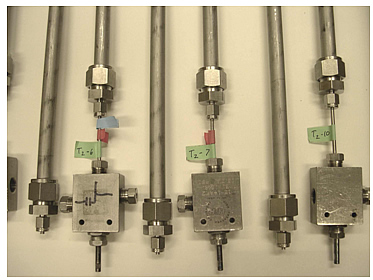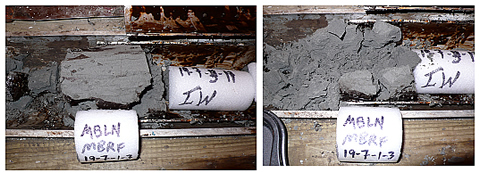In addition to the information provided here, a full listing of project related publications and presentations as well as a listing of funded students can be found in the Methane Hydrate Program Bibliography [PDF].
2008 ICGH Paper - Distribution of the Dominant Microbial Communities in Marine Sediments Containing High Concentrations of Gas Hydrates [PDF]
Fire in the Ice article, [PDF-883KB] " Methanogenesis in hydrate-bearing sediments: integration of experimental and theoretical approaches" by Colwell, F., W. Ussler, and G. Dickens, 2006 - Winter edition - 2006, pg. 1
Pertinent Publications
F. Colwell, A. Hangsterfer, E. Brodie, R. Daly, M. Holland, B. Briggs, P. Carini, M. Torres, M. Kastner, P. Long, H. Schaef, M. Delwiche, W. Winters, “Fine scale control of microbial communities in deep marine sediments that contain hydrates and high concentrations of methane,” [PPT - 5.19MB] Moscone Center, San Francisco, CA; American Geophyscial Union, Fall Meeting; Dec 10-14, 2007.
Colwell, F., T. Nunoura, M. Delwiche, S. Boyd, R. Bolton, D. Reed, K. Takai, R. Lehman, K. Horikoshi, D. Elias, and T. Phelps, 2005, Evidence of minimal methanogenic numbers and activity in sediments collected from the JAPEX/JNOC/GSC et al. Mallik 5L-38 gas hydrate production research well: in Dallimore, S. and T. Collett, eds., Scientific Results from the Mallik 2002 Gas Hydrate Production Research Well Program, Mackenzie Delta, Northwest Territories, Canada, Geological Survey of Canada Bulletin, Bulletin 585, p. 102.
Colwell, F., and R. Smith, 2004, Unifying principles of the deep terrestrial and deep marine biospheres, in Wilcock, W., E. Delong, D. Kelley, J. Baross, and S. Cary, eds., Subseafloor Biosphere at Mid-Ocean Ridges: Geophysical Monograph Series, v. 104. American Geophysical Union, Washington, D.C., p. 355-367.
Colwell, F., M. Delwiche, D. Blackwelder, R. Cherry, J. Mikucki, Y. Liu, D. Boone, and T. Uchida, 2002, Evidence of broad thermal tolerance of methanogens in sediments containing gas hydrates. Proceedings of the 4th International Conference on Gas Hydrates, Yokohama, Japan, p. 19-24.
Colwell, F., M. Delwiche, D. Blackwelder, M. Wilson, R. Lehman, and T. Uchida, 1999, Microbial communities from core intervals, JAPEX/JNOC/GSC Mallik 2L-38 gas hydrate research well: in Dallimore, S., T. Uchida, and T. Collett, eds., Scientific Results from JAPEX/JNOC/GSC Mallik 2L-38 Gas Hydrate Research Well, Mackenzie Delta, Northwest Territories, Canada: Geological Survey of Canada, Bulletin 544. pp. 189-195
Colwell, F., R. Matsumoto, and D. Reed, 2004, A review of the gas hydrates, geology and biology of the Nankai Trough. Chemical Geology, v. 205, p. 391-404.
Inagaki, F., T. Nunoura, S. Nakagawa, A Teske, M. Lever, A. Lauer, M. Suzuki, K. Takai, M. Delwiche, F. Colwell, K. Nealson, K. Horikoshi, S. D’Hondt, and B. Jørgensen, 2006, Biogeographical distribution and diversity of microbes in methane hydrate-bearing deep marine sediments on the Pacific Ocean Margin. Proc. Nat. Acad. Sci. USA. 103: 2815-2820.
Lorenson, T., F. Colwell, M. Delwiche, and J. Dougherty, in review, Acetate and hydrogen concentrations in pore fluids associated with a large gas hydrate reservoir, offshore Oregon, USA. Ocean Drilling Program, Leg 204, Data Reports.
Lorenson, T.D., F.S. Colwell, M. Delwiche, and J.A. Dougherty. 2006. Data report: Acetate and hydrogen concentrations in pore fluids associated with a large gas hydrate reservoir, southern Hydrate Ridge, offshore Oregon, USA. In Tréhu, A.M., Bohrmann, G., Torres, M.E., and Colwell, F.S. (Eds.), Proc. ODP, Sci. Results, 204 [Online]. Available from World Wide Web: http://www-odp.tamu.edu/publications/204_SR/126/126.htm [external site].
Mikucki, J., Y. Liu, M. Delwiche, F. Colwell, and D. Boone, 2003, Isolation of a Methanogen from deep marine sediments that contain methane hydrates, and description of Methanoculleus submarinus sp. nov. Applied and Environmental Microbiology, v. 69, p. 3311-3316.
Reed, D., Y. Fujita, M. Delwiche, D. Blackwelder, P. Sheridan, T. Uchida, and F. Colwell, 2002, Microbial communities from methane hydrate-bearing deep marine sediments in a forearc basin. Applied and Environmental Microbiology, v. 68, p. 3759-3770.
Trehu, A.M., M.E. Torres, G. Bohrmann, and F.S. Colwell. 2006. Leg 204 synthesis: Gas hydrate distribution and dynamics in the central Cascadia accretionary complex, pgs 1-40. In (A.M. Trehu, M.E. Torres, G. Bohrmann, and F.S. Colwell, eds.). Proc. ODP, Sci. Results, 204: College Station, TX (Ocean Drilling Program), doi:10.2973/odp.proc.sr.204.101.2006; http://www-odp.tamu.edu/publications/204_SR/synth/synth.htm [external site]
Presentations
Boyd, S., et al., 2004, Determination of methanogen biomass in hydrate-bearing sediments by quantitative PCR: Annual Meeting of the American Society for Microbiology Annual Meeting, New Orleans, LA. May.
Colwell, F., S. Boyd, M. Delwiche, and D. Reed, 2005, Rates of biological methane production in sediments: 4th International Workshop on Gas Hydrates, Victoria, BC.
Colwell, F., T. Lorenson, S. Boyd, M. Delwiche, D. Reed, and D. Newby, 2005, Experimentally determined rates of methanogenesis in methane-bearing sediments: Geological Society of America Annual Meeting, Salt Lake, UT. October 16-19.
Colwell, F., S. Boyd, M. Delwiche, and D. Reed, 2004, Realistic Rates of Biological Methane Production in Hydrate Bearing Sediments: The American Association of Petroleum Geologists Hedberg Conference, Vancouver, BC., September 12-16.
Colwell, F., M. Delwiche, D. Reed, S. Boyd, T. Nunoura, K. Takai, and the ODP Leg 204 Shipboard Scientific Party, 2003, Microbiology of hydrates: searching for the methane source term: Goldschmidt Conference, Kurashiki, Japan, September.
Colwell, F., et al, 2003, Microorganisms of methane hydrates: Down but not out: Annual Meeting of the American Association for the Advancement of Science (AAAS), Denver, CO. February.
Colwell, F., M. Delwiche, D. Reed, S. Boyd, T. Nunoura, F. Inagaki, and K. Takai, 2003, Geomicrobiology and methanogenesis in accretionary complexes: American Geophysical Union Fall Meeting, San Francisco, CA. December.
Colwell, F., et al., 2003, Microorganisms of methane hydrates: Down but not out: Goldschmidt Conference, Kurashiki, Japan. September. Keynote address.
Colwell, F., D. Reed, Y. Fujita, M. Delwiche, D. Blackwelder, T. Uchida, T. Fujii, and H. Lu, 2001, Deep-subsurface marine methane hydrate microbial communities: Who’s there and what are they doing?: American Geophysical Union, Fall Meeting, San Francisco, CA. December.
Colwell, F., M. Dewiche, D. Blackwelder, Y. Fujita, and T. Uchida, 2000, Microbial methane production and biomass in the Nankai Trough: Western Pacific Geophysics Meeting, Tokyo, Japan. June.
Colwell, F., 1999, Subsurface microbial communities in sediments bearing methane hydrates: Engineering Foundation Meeting, Salt Lake City, UT. July.
Inagaki, F., T. Nunoura, M. Suzuki, K. Takai, K. Nealson, K. Horikoshi, M. Delwiche, F. Colwell, and B. Jorgensen, 2003, Microbial community structures in methane hydrate bearing deep marine sediments form the Peru Margin (ODP Leg 201) and the Cascadia Margin (ODP Leg 204): American Geophysical Union, Fall Meeting, San Francisco, CA, December.
Nunoura, T., K. Takai, K. Nealson, K. Horikoshi, M. Delwiche, F. Colwell, and ODP leg 204 Shipboard Scientific Party, 2003, The microbial community structure of methane hydrate bearing deep subseafloor sediments in Cascadia Margin (ODP Leg204): Goldschmidt Conference, Kurashiki, Japan. September.






